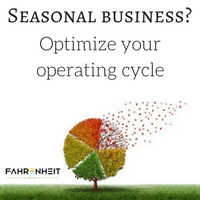Seasonal Business? Optimize Your Operating Cycle

Every business has some degree of ups and downs during the year. But cash flow fluctuations are much more intense for seasonal businesses. So, if your company defines itself as such, it’s important to optimize your operating cycle to anticipate and minimize shortfalls.
A High-Growth Example
To illustrate: Consider a manufacturer and distributor of lawn-and-garden products, such as topsoil, potting soil, and ground cover. Its customers are lawn-and-garden retailers, hardware stores, and mass merchants.
The company’s operating cycle starts when customers place orders in the fall — nine months ahead of its peak selling season. So, the business begins amassing product in the fall, but curtails operations in the winter. In late February, product accumulation continues, with most shipments going out in April.
At this point, a lot of cash has flowed out of the company to pay operating expenses, such as utilities, salaries, raw materials costs, and shipping expenses. But cash doesn’t start flowing into the company until customers pay their bills around June. Then, the company counts inventory, pays remaining expenses, and starts preparing for the next year. It’s strategic selling window — which will determine whether the business succeeds or fails — lasts a mere eight weeks.
The Power of Projections
Sound familiar? Ideally, a seasonal business such as this should stockpile cash received at the end of its operating cycle, and then use those cash reserves to finance the next operating cycle. But cash reserves may not be enough — especially for high-growth companies.
So, like many seasonal businesses, you might want to apply for a line of credit to avert potential shortfalls. To increase the chances of loan approval, compile a comprehensive loan package, including historical financial statements and tax returns, as well as marketing materials and supplier affidavits (if available).
More important, draft a formal business plan that includes financial projections for next year. Some companies even project financial results for three to five years into the future. Seasonal business owners can’t rely on gut instinct. You need to develop budgets, systems, processes, and procedures ahead of the peak season to effectively manage your operating cycle.
Distinctive Challenges
Seasonal businesses face many distinctive challenges, but our professionals can help. Contact us. We’re ready to help you overcome these obstacles and strengthen your bottom line.